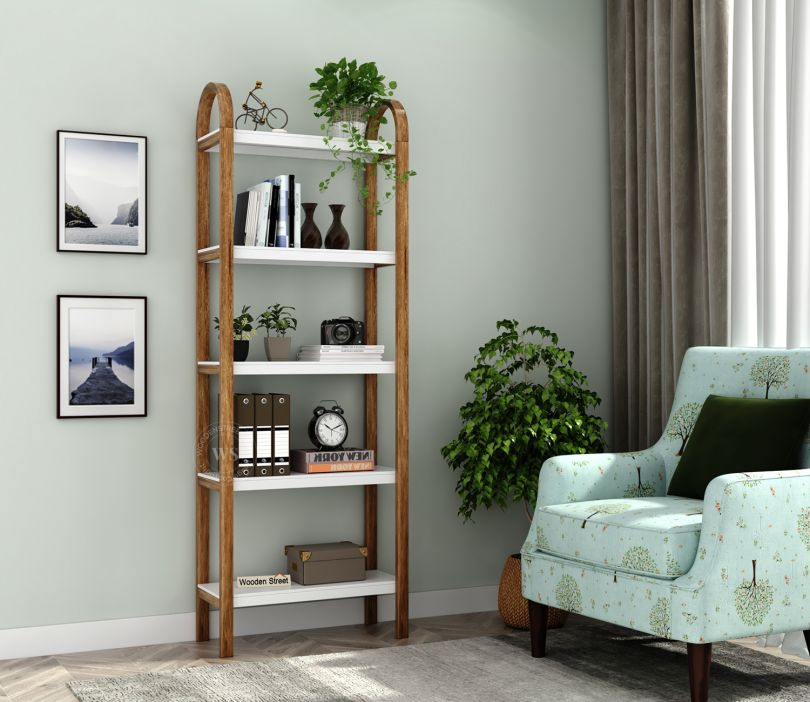In a world overflowing with digital distractions, physical bookshelves remain a cherished haven for avid readers. Yet, as collections grow, so does the clutter—dusty tomes, unread stacks, and mismatched decor can turn a cozy nook into a chaotic eyesore. Decluttering your bookshelf not only frees up space but also reignites joy in your literary treasures. This guide walks you through the process, with tips inspired by professional organizers, and explores how thoughtful bookshelves design from brands like Wooden Street can elevate the results.

Why Declutter Your Bookshelf?
Cluttered bookshelves can weigh on your mind, evoking guilt over unread books or frustration from disorganization. The benefits are clear: a streamlined shelf improves aesthetics, reduces stress, and makes room for new favorites. Start by assessing your space—measure shelves to understand capacity and envision a balanced look with breathing room between items. For those upgrading, a wooden book rack offers durable, stylish storage that aligns with modern homes.
Step 1: Prepare and Empty the Shelves
Begin with mental preparation—set aside a few hours and clear a workspace like a table or floor. Gather supplies: boxes for sorting (keep, donate, sell, recycle), dust cloths, and labels. The key action: remove everything from the bookshelf. Pull books forward or take them off entirely to reveal the full extent of clutter, including forgotten knick-knacks or duplicates. Dust shelves thoroughly using a microfiber cloth or soft brush to prevent allergens. This step, though messy, provides clarity—you can’t declutter what you can’t see.
Step 2: Sort and Decide What to Keep
With books piled out, sort by category: fiction, non-fiction, cookbooks, or genres like self-help and travel. Ask key questions to purge: Have I read it? Does it spark joy (à la Marie Kondo)? Is it available digitally or at the library? Would I reread it or recommend it? Discard damaged books—recycle paperbacks directly, but remove hardcovers’ non-recyclable covers. For unread titles, check reviews on platforms like Goodreads to gauge interest. Aim to keep only what fits your shelf space; excess signals it’s time to let go. Non-fiction outdated like old travel guides? Donate them.
Step 3: Handle the Discards
Sort keepers aside, then address the rest. Donate gently used books to libraries, schools, or charities—many accept them year-round. Sell valuable editions online or at bookstores for cash incentives. For emotional attachments, like gifted books, keep if they hold deep value, but release the rest to make space for joy. This step transforms guilt into liberation, as one organizer notes: decluttering creates room for what truly matters.
Step 4: Clean and Reorganize
Wipe down books lightly before reshelving. Organize strategically: by genre and author for easy access, or by color for visual appeal. Mix orientations—stand most upright, lay a few flat for vignettes, and add subtle decor like plants or bookends. Use clear acrylic risers for height variation without cluttering. Pull books to the front of shelves, leaving minimal floor space visible for a polished look. Incorporate baskets for paperbacks or less-used items to maintain tidiness. Less is more—embrace negative space to avoid overwhelming the eye.
Enhancing with Bookshelves Design from Wooden Street
Once decluttered, consider refreshing your setup with quality furniture. Wooden Street specializes in bookshelves design that blend functionality and style, using sustainable woods like Sheesham for durability and a warm finish. Their wooden book rack options, such as ladder or corner units, maximize space in small rooms while offering open or closed storage to protect against dust. Industrial lofts or modular shelves adapt to any decor, ensuring your organized collection shines. These pieces turn decluttering into an opportunity for a more inviting, personalized library.
Personalizing Your Bookshelf Aesthetic
Beyond organization, your bookshelf can reflect your personality. Consider thematic displays, like grouping travel books with a small globe or art books near a framed print. Rotate seasonal decor—think autumnal hues or winter-themed bookends—to keep the space dynamic. If you’re a collector, showcase rare editions on a dedicated shelf within your wooden book rack, using subtle lighting to highlight their value. Personal touches elevate the bookshelf from mere storage to a storytelling centerpiece in your home.
Managing Digital and Physical Collections
In the digital age, balancing physical and e-books is key. If your bookshelf is overflowing, consider digitizing select titles—many classics are available on platforms like Kindle or Project Gutenberg. This reduces physical clutter while preserving access. However, don’t forsake the tactile joy of physical books; instead, curate a mix that suits your space. For instance, keep beloved hardcovers on display and store paperbacks in baskets on a Wooden Street bookshelf design, blending practicality with charm.

Involving Family or Housemates
Decluttering can be a group effort, especially in shared spaces. Enlist family or housemates to sort their own books, fostering accountability and speeding up the process. Set ground rules: each person keeps only what fits their allocated shelf space. For kids’ collections, prioritize sturdy board books or favorites on lower shelves of a wooden book rack for easy access. Collaborative decluttering builds a shared commitment to maintaining an organized, clutter-free bookshelf.
Long-Term Storage Solutions
For books you love but rarely use, like reference texts or seasonal reads, consider long-term storage. Use acid-free boxes or archival sleeves to protect them from dust and damage, storing them in a dry, cool place. Alternatively, Wooden Street’s modular bookshelf design offers hidden compartments for less frequently accessed items, keeping them out of sight but within reach. Label storage clearly to avoid future clutter creep, ensuring your main bookshelf remains a curated showcase.
Maintenance Tips for Lasting Order
Prevent future clutter by adopting habits: limit new acquisitions to one-in-one-out, or digitize where possible. Schedule quarterly reviews, enlisting family for efficiency. Dust regularly and rotate displays seasonally for freshness. With these practices, your bookshelf becomes a source of inspiration, not overwhelm.
Decluttering a bookshelf is an act of self-care, reclaiming space for what brings happiness. Whether keeping classics or investing in a sleek wooden book rack, the result is a serene, stylish sanctuary tailored to you.

